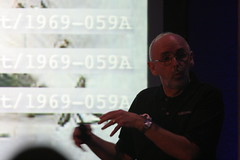 This post was initially just going to be about the presentation The Simple Power of the Link that I gave in the opening session of The Semantic Tech & Business Conference in London earlier this week. However I realise now that it’s title, chosen to draw attention to the core utility and power of the basic links in Linked Data, has resonance and relevance for the conference as a whole.
This post was initially just going to be about the presentation The Simple Power of the Link that I gave in the opening session of The Semantic Tech & Business Conference in London earlier this week. However I realise now that it’s title, chosen to draw attention to the core utility and power of the basic links in Linked Data, has resonance and relevance for the conference as a whole.
This was the first conference in the long running Semtech series to venture in to Europe as well as include the word business in it’s name. This obviously recognises the move, from San Francisco based geekdom to global pragmatic usefulness, that the Semantic Web in general and Linked Data in particular is in the process of undertaking. A maturing of the market that we in Talis Consulting can attest to having assisted many organisations with their understanding and adoption of Linked Data. In addition to those attendees, that I would characterise as the usual suspects, the de-geeking of the topic attracted many who would not previously of visited such a conference. An unscientific show of hands, prior to the session in which I presented, indicated that about half of the audience were new to this Semantic stuff.
Traffic on our stand in the exhibition area also supported this view, with most discussions being about how the techniques and technologies could be applied, and how Talis could help, as against esoteric details of the technologies themselves. Linking people with real world issues and opportunities, with the people that have the experience to help them, was an obvious benefit of the event. In addition to as having some great keynotes, as Rob described.
So, back to my initial purpose.
The presentation “The Simple Power of the Link” was an attempt to simplify the core principles of Linked Data so as to highlight their implicit benefits. The aforementioned geekdom that has surrounded the Semantic Web has, unfairly in my mind, gained the topic a reputation for being complex and difficult and hence not really applicable in the mainstream. A short Google on the topic will rapidly turn up a set of esoteric research papers and discussions around things such as inferencing, content-negotiation and Sparql – a great way to put off those looking for an easy way in.
[slideshare id=9419242&doc=thesimplepowerofthelink-110926000806-phpapp01]
There is a great similarity to the way something like vehicle engineering is promoted with references to turbos, self levelling suspensions, flappy-paddle gearshifts, iPod docks and the like – missing the point for the [just landed on the planet] new to the topic – that the major utility of any vehicle is that it goes, stops, steers, and gets you from A to B.
The core utility of Linked Data is The Link. A simple way to indicate the relationship between one thing and another thing.
As things in Linked Data are represented by http URIs, which when looked up should return you some data containing links to other things, an implicit web of relationships emerges that you can follow to obtain more related information. This basic, and powerful, utility could be simply realised with data encoded as triples in RDF, served from a simple file structure by a web server.
So, although things like triple stores, OWL, relational-to-RDF mapping tools, named graphs, SPARQL 1.1, and [the dreaded] httpRange-14 are important issues for those embedded in Linked Data, the overwhelming benefits that accrue from applying Linked Data come from those basic triples – the links. As a community I believe that we can be rightly accused of not making that clear enough. Something that my colleagues in Talis Consulting and I attempt to address whenever possible. Especially at our open Linked Data events.
This post was also published on the Talis Consulting Blog